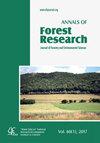Seasonal changes in water absorbability of some litterfall compoSeasonal changes in water absorbability of some litterfall components in Scots pine stands differing in agenents in Scots pine stands differing in age
IF 1.7
3区 农林科学
Q2 FORESTRY
引用次数: 1
Abstract
Understanding the water-holding capacity of the litter layer is of interest when constructing forest hydrology models, where the presence of litter affects soil moisture content and fire behavior. However, to understand the process of water storage in the litter layer it is not only important to know (i) how much water the litter layer can store, but also (ii) how much water particular litter components can store. Little is known about the role of organic matter chemistry in water absorption and saturation of its internal capillarity. We hypothesized that water absorption of freshly fallen organic matter changes with stand age and during the year, i.e. the term when organic matter falls (month of the year or season) affects its water absorbability. Thus, we determined seasonal changes in water absorption time, carbon and nitrogen contents, and the C/N ratio of bark and needles taken from Scots pine stands of different ages during laboratory tests. Pine needles and bark were collected every month for one year in five stands in north-western Poland. The time of water absorption for bark was about 30% shorter than that of needles. The age of the stand did not affect the time of water absorption in the litterfall components. We observed that the term when litter falls (month of the year or season) significantly affected the water absorption time. It indicates that organic matter reaching the forest floor and forming the litter layer is characterized by different output properties affecting the water storage capacity of the litter layer.不同药剂对不同林龄的松林凋落物部分组分吸水能力的季节变化
在构建森林水文模型时,了解凋落物层的持水能力是有意义的,因为凋落物的存在会影响土壤水分含量和火灾行为。然而,要了解凋落物层的蓄水过程,不仅要知道(i)凋落物层能储存多少水,而且要知道(ii)特定凋落物组分能储存多少水。对于有机质化学在水吸收及其内部毛细饱和中的作用,人们知之甚少。我们假设新落有机质的吸水率随林龄和年份的变化而变化,即有机质下降的时间(一年中的月份或季节)影响其吸水率。因此,我们在实验室测试中测定了不同年龄的苏格兰松林的树皮和针叶的吸水时间、碳氮含量和碳氮比的季节变化。在波兰西北部的五个林分中,每个月收集一次松针和树皮,持续一年。树皮吸水时间比针叶吸水时间短30%左右。林龄对凋落物组分吸水时间没有影响。我们观察到凋落物的时间(一年中的月份或季节)对吸水时间有显著影响。这表明,到达森林地面并形成凋落物层的有机质具有不同的输出特性,影响凋落物层的蓄水能力。
本文章由计算机程序翻译,如有差异,请以英文原文为准。
求助全文
约1分钟内获得全文
求助全文
来源期刊

Annals of Forest Research
FORESTRY-
CiteScore
2.20
自引率
11.10%
发文量
11
审稿时长
12 weeks
期刊介绍:
Annals of Forest Research is a semestrial open access journal, which publishes research articles, research notes and critical review papers, exclusively in English, on topics dealing with forestry and environmental sciences. The journal promotes high scientific level articles, by following international editorial conventions and by applying a peer-review selection process.
 求助内容:
求助内容: 应助结果提醒方式:
应助结果提醒方式:


